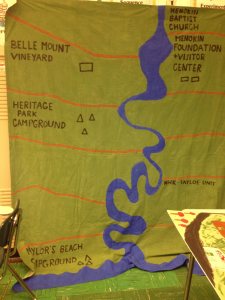 The students of Mrs. Ptucha’s 6th-grade science classes at Richmond County Intermediate School had the opportunity to dive into the Chesapeake Bay Watershed recently – with paint and brushes. The students participated in a Project WET activity, Make-a-Mural.
The students of Mrs. Ptucha’s 6th-grade science classes at Richmond County Intermediate School had the opportunity to dive into the Chesapeake Bay Watershed recently – with paint and brushes. The students participated in a Project WET activity, Make-a-Mural.
They created a mural depicting various aspects of the Northern Neck watershed area, including its landscape, people, cultures, and natural residents – both plant and animal.
The objective of the project was for the students to define the term watershed; identify their local watershed and illustrate it, including water resource issues within it.
identify their local watershed and illustrate it, including water resource issues within it.
Using resource information such as an Enviroscape of Menokin and Watershed Maps, and a diagram of the main components of a watershed (Air, Land, Water, People & Transportation, Architecture, History and Tradition) the students listed examples of each category that are included in their local watershed.

Lastly they studied History & Traditions: what are ways resources have been used in the past that are different from how they are used today? Using the example of Menokin’s cultures and traditions, these ideas were discussed:
- The biggest influence on the watershed can be understood through the categories of People and Traditions.
- Menokin’s people begin with the Rappahannock Indian Tribes, Francis Lightfoot Lee and subsequent owners, including the current Menokin Foundation.
- The Land and its use has changed some over time. Originally used mostly for farming and grazing, most of the land is now under a conservation easement and only a small portion is cultivated.
- The Menokin Foundation is now developing the site as an educational and cultural center with a focus on historic and environmental education. As a result, more buildings may be added to the landscape to accommodate these goals. There are also plans to further develop the trail system for visitors use. In doing so, what sort of BMPs (best management practices) should need to be considered for each area of the watershed?
With all of this new-found knowledge and food for thought swirling in their heads,  the students were then asked to begin on the mural. Using foam core panels, and acrylic paint, each student worked on designated portions of the watershed – air, land and water.
the students were then asked to begin on the mural. Using foam core panels, and acrylic paint, each student worked on designated portions of the watershed – air, land and water.
As you can see from the finished mural above, the results are outstanding. Using color and expression in a way only children can master, the finished product is a true work of art  and is hanging in the hallway at the school.
and is hanging in the hallway at the school.
Funding for the A River Runs Through Us Meaningful Watershed Educational Experience was provided by the Chesapeake Bay Trust.
Programming funds were also made possible from a generous environmental grant from the Dominion Foundation.
The program was coordinated by TREE (Three Rivers Environmental Educators) and Alice French, Education and Outreach Coordinator at The Menokin Foundation. This was the first of several programs developed by TREE for Richmond County School and their STEM initiative.

One thought on “Exploring The Watershed Through Art”